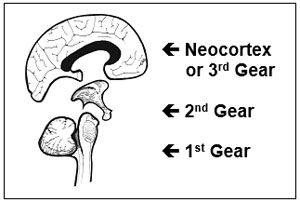Anxiety, Old Habits, and Weight Management
©Arlene R. Taylor PhD www.arlenetaylor.org
You can free yourself from old habits—consciously
 “Every time I get anxious about my weight or my favorite foods, my weight-management strategies fly right out the window!" Ethan sighed. "Before I know it I'm right back in my old eating habits. Go figure!”
“Every time I get anxious about my weight or my favorite foods, my weight-management strategies fly right out the window!" Ethan sighed. "Before I know it I'm right back in my old eating habits. Go figure!”
“Anxiety, while exceedingly common on this planet, can be a very insidious enemy. It has sabotaged many a good plan because it can trigger a natural brain phenomenon known as downshifting. Uunderstanding how it interferes with conscious thought may put you a jump ahead of most people on this planet,” said his wellness coach.
 Think of the three main brain layers as resembling gears in an automatic transmission. Gears one and two involve subconscious thought. First gear primarily focuses on what is happening in the present moment, while second gear adds recall of what happened in the past. Imagining and planning a course of action utilize functions located in the third gear or neocortex (new brain). This region, right behind your forehead, contains many additional executive functions including goal setting, decision making, willpower, and morality, to name just a few. Ready access to these functions is key to successful weight management. When downshifted, access to those high-level functions is inconsistent or difficult. You’re more likely to be successful when you are consciously mindful and aware. His coach explained: “The goal is to prevent unnecessary downshifting by managing your thoughts of fear and anxiety and to upshift quickly when you recognize you are downshifted—and there is no actual or imminent danger for your brain to deal with.”
Think of the three main brain layers as resembling gears in an automatic transmission. Gears one and two involve subconscious thought. First gear primarily focuses on what is happening in the present moment, while second gear adds recall of what happened in the past. Imagining and planning a course of action utilize functions located in the third gear or neocortex (new brain). This region, right behind your forehead, contains many additional executive functions including goal setting, decision making, willpower, and morality, to name just a few. Ready access to these functions is key to successful weight management. When downshifted, access to those high-level functions is inconsistent or difficult. You’re more likely to be successful when you are consciously mindful and aware. His coach explained: “The goal is to prevent unnecessary downshifting by managing your thoughts of fear and anxiety and to upshift quickly when you recognize you are downshifted—and there is no actual or imminent danger for your brain to deal with.”
“How do I get upshifted quickly so I can follow my program by design?” asked Ethan.
“First, you need to know when you’re downshifted. Then you need to activate a preplanned strategy. I have two. Initially I try to find something humorous about the situation and laugh. When that happens, I know I’m upshifted because humor and laughter are in that third brain layer. My other strategy is to think of something for which to be grateful. Studies have shown it’s virtually impossible to be fearful or anxious and grateful at the same time. I can always think of something for which to be grateful.”
His coach paused for a moment and then added: “Select your preplanned strategies for upshifting and use them as necessary.”
“I can do that,” said Ethan. “I have a good sense of humor and much to be grateful for. But I’ve had some of these old habits for decades. Some are pretty strong. Is there hope?”
“There’s always hope! Remember, the brain is designed to create habits. When you do something once, the brain begins creating brain software in case you want to do the same thing again. Once developed, these neuron highways cannot be deleted per se, since neurons do not multiply and divide as do other cells. You create them; you’ve got them. That’s the bad news. Fortunately, there’s also good news. Create a new pattern of behavior and practice it consistently for 21 days, and the brain coats the new neuron highway with multiple layers of insulation. Practice for another 21 days and Voila! the new habit will be pretty much in place and will continue to strengthen with practice.
“After you have developed a new habit, start working on another and eventually another. That’s how you build and implement a high-level wellness lifestyle. Let’s say you have brain software for collapsing on the couch after dinner and snacking on chips and candy until bedtime. Your new plan is to take a 15-minute walk after dinner. Take a walk on day one and check it off on the calendar. By the end of two 21-day cycles you’ll probably be so used to walking you’ll not bother to check it off on the calendar. If you let down your guard, however, you may find yourself following the old neuron highway. Should that occur, get right back on the program.” His coach smiled. Ethan smiled back.
“Meantime,” his coach continued, “remove all unhealthy snacks from the house and have plenty of fresh water, apples, celery, and other preferable foods and beverages easily available. You will still need to make choices and use willpower to follow through on those choices. Willpower was designed to help you develop a new or replacement behavior—not to stop doing an undesirable behavior. Tell your brain often: ‘You are walking for 15 minutes and you feel better.’ Speak in the present tense, as if it’s a done deal. When you speak in future tense—you will, you’re going to—the brain may think: That’s in the future. I don’t need to do anything now. When you speak in the present tense, the brain wakes up, so to speak, and gets in gear to help you now.”
“I get the importance of upshifting," said Ethan. "Thanks for helping me understand that it takes conscious thought to create or modify habits. And I know better now how to talk to myself.”
Bottom line: You created your old habits; pieces of brain “software” that follow neuron highways. The bad news? Once developed, they cannot be deleted per se. The good news? You can free yourself from habits that are giving you negative outcomes by creating new or replacement habits and working with your brain to implement them, one at a time. If you realize you are downshifted, implement a preplanned strategies to upshift. Staying in that third brain layer, consciously aware, will help you stay on track with your weight management program.

